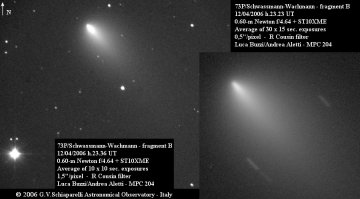 Did you sleep through the auroras? Next time get a wake-up call. Sign up for Spaceweather PHONE.
Did you sleep through the auroras? Next time get a wake-up call. Sign up for Spaceweather PHONE.
A PLANET NAMED GEORGE: This month Venus can lead you to a naked-eye planet that ancient astronomers inexplicably failed to notice. Get the full story from Science@NASA.
EGG MOON: According to folklore, tonight's full moon is the Egg Moon. Go outside and take a look; what you see may give you some good ideas for coloring Easter eggs. Craters. Rays. Mountain ranges. Finally, you can put all those cracked shells to good use!

Above: The Egg Moon photographed by Darrell Spangler of Drake, Colorado.
Other names for April's full moon are the Pink Moon, the Fish Moon, the Sprouting Grass Moon and even the Tax Moon. So close to Easter, however, Egg Moon seems best.
COMET NEWS: Astronomers are monitoring the many fragments of dying comet 73P/Schwassmann-Wachmann as it approaches Earth for a close encounter in May 2006. Two new developments: Fragment B is in an accelerated state of decay. The mini-comet has become elongated and no longer displays a central condensation, according to IAU Electronic Telegram No. 473. (continued below)

Above: High-resolution images of Fragment B on April 12th. Photo credit: Aletti Andrea and Buzzi Luca of the Schiaparelli Observatory in Varese, Italy.
Pictured above, fragment B is glowing like a 9th magnitude star, making it an easy target for backyard telescopes and CCD cameras. Amateur astronomers can actually watch this comet fall apart: sky map, ephemeris.
Meanwhile, further along the "string of pearls," fragment G has also split. Fresh ice exposed by the disruption is vaporizing, causing the comet to brighten nearly 15-fold since April 2nd. With a visual magnitude of 12 (IAU Circular No. 8701), fragment G is more challenging for amateurs, but no less tempting: sky map, ephemeris.

